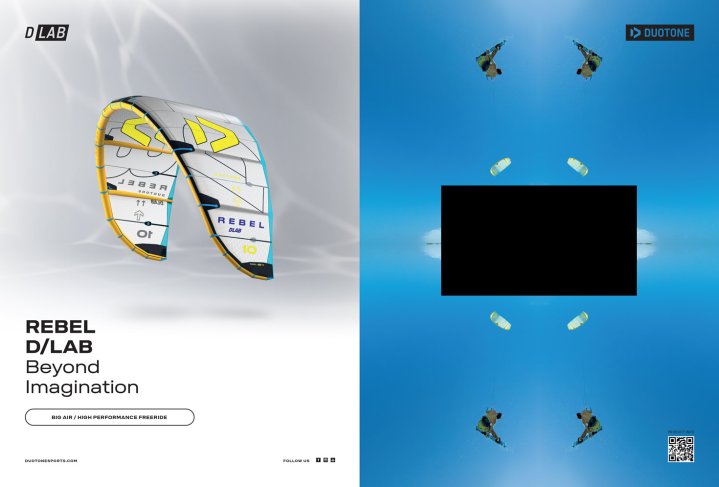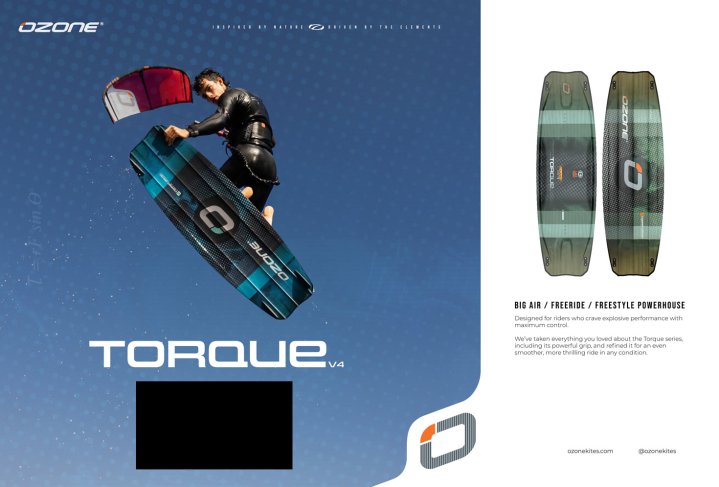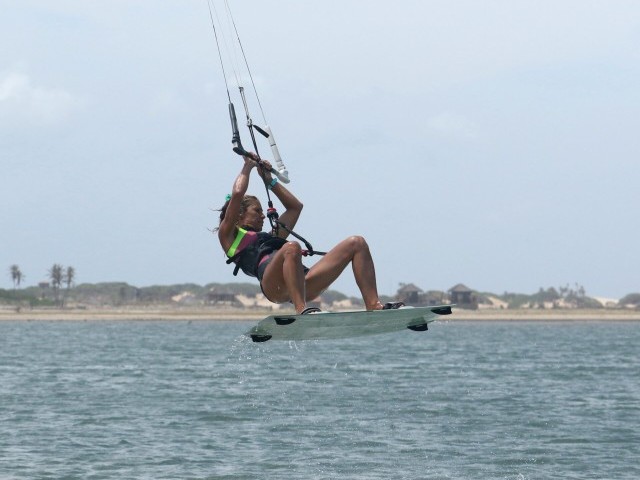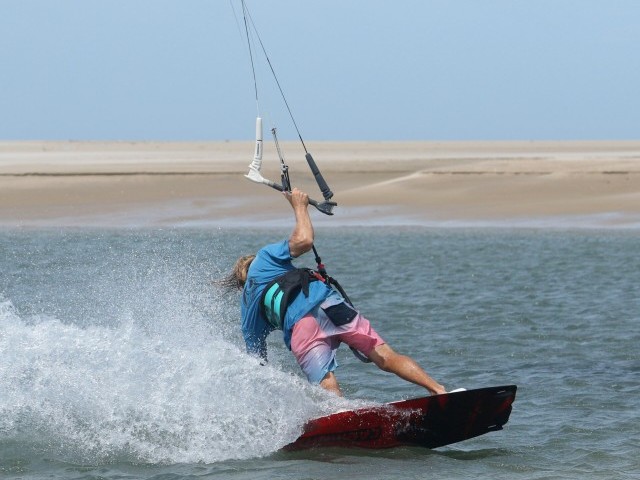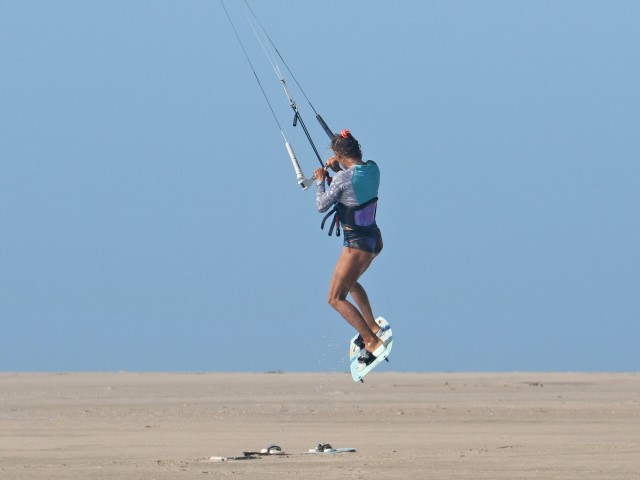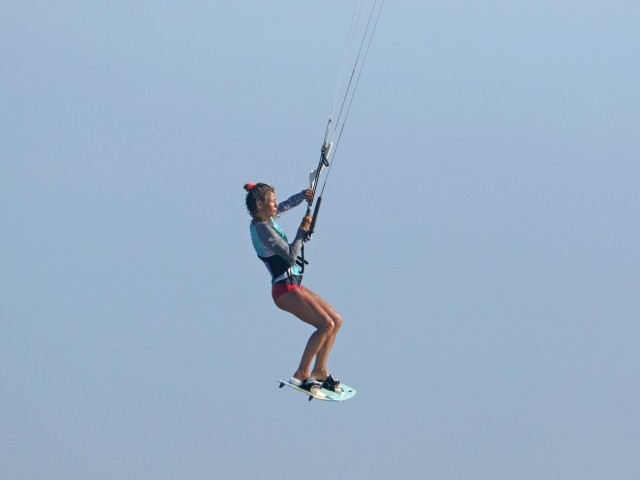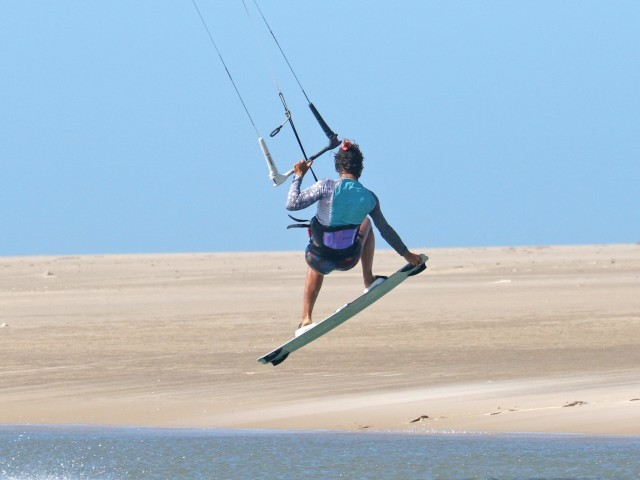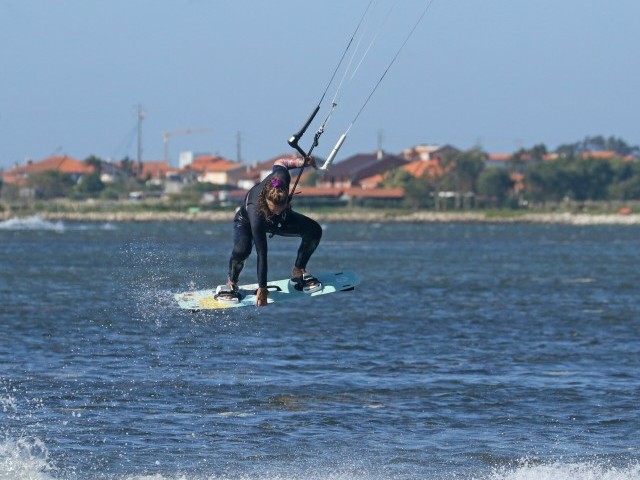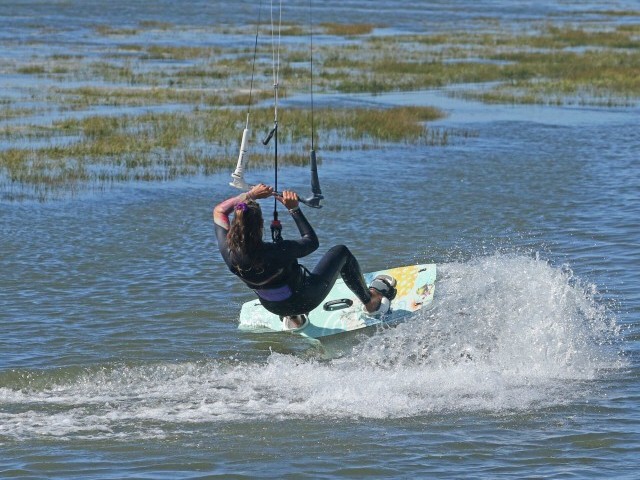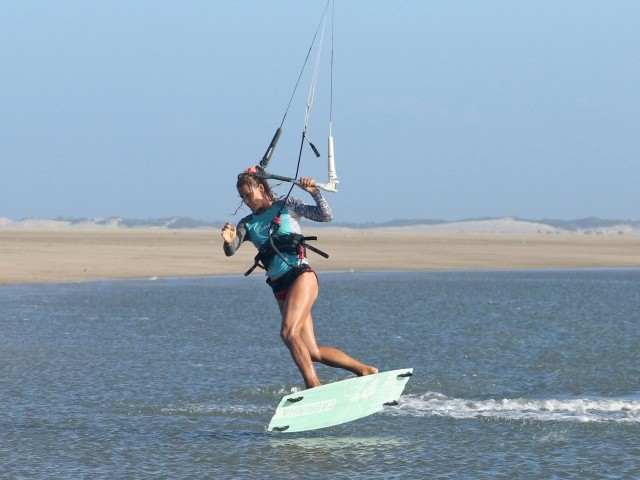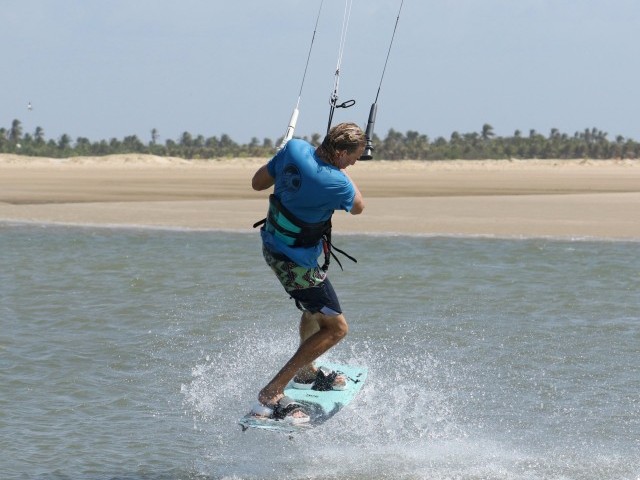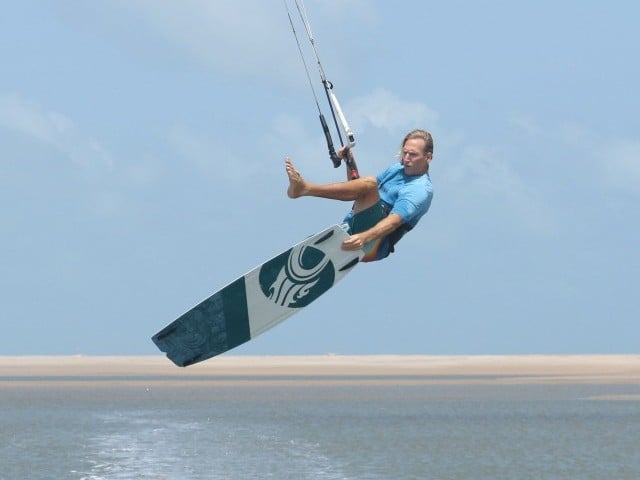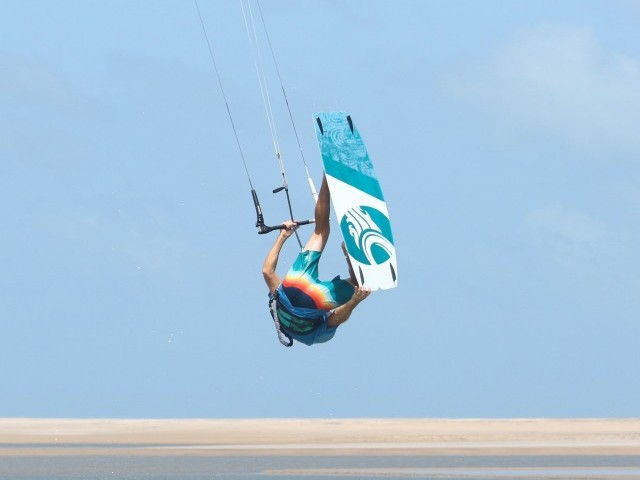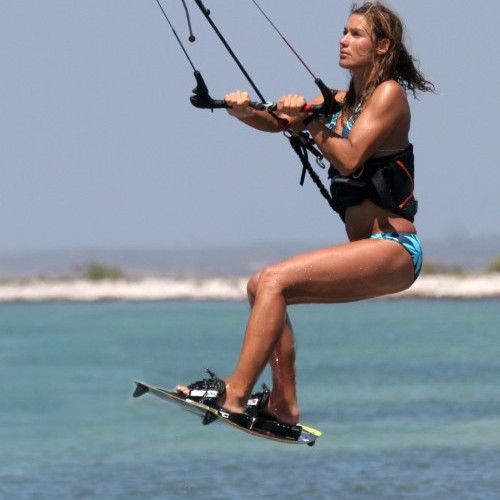
Air Gybe with Late Kite Loop
Technique / Intermediate
Introduction
This move is really as much a cheat as it is a trick, and a very useful one at that. If the title doesn’t give away what it is have a look at Video 1. A late kite loop in this case means that the kite loops once you are on the water, not in the air. You’ve probably seen it many times before, but the chances are when you did, you didn’t think “oh they really should have kept the kite above them for a picture book transition.” The fact of the matter is when your kite control goes southward whilst changing direction in the air, doing this will you give a nice bit of pull and save your bacon.
A positive outlook would forecast a few more benefits of combining this to the humble air gybe. Firstly if you’re adding grabs into your air gybes it’ll give you the chance to hold them for longer and rack up the style points whilst still exiting with speed. On smaller kites there is more chance of steering your kite too far behind you and this yet again is a perfect solution. More old school pop transitions often result in you penduluming away from the kite. Once more this is the antidote.
In short, if you sometimes (be honest) find your kite low and way to the side when you’re hoping to plane out of a transition, this little monkey will whip a handy boost of power right where and when you need it, and those days of sinking down will be banished.
And finally this can be an exceptionally comfortable way of building up your confidence and skills in anticipation of a bona fida kite loop. Game on!
One word of warning though, if you have never voluntarily looped your kite we would strongly recommend learning the under turn first, see Issue 4.
Big Points
As with any attempt to air gybe it will still benefit you to try and get the fundamentals right and add the late kite loop onto the end rather than try to deliberately fluff it. We will be repeating ourselves but to save you looking elsewhere lets quickly ponder the approach and take off.
So have a quick perusal of Pic A. in which Karine is about to take off. Karine has approached with speed and her kite no lower than 1 o’clock. To drop speed she has carved into wind by positioning her weight over her back foot, moving her hips towards the tail of the board and straightening her front leg. The straight front leg keeps the board on its edge. Karine has already steered the kite back aggressively and has the bar pulled into the sweet spot (her back lines are tight). From this position Karine can jump up off her back leg into her air gybe. So far so good!
Now Pic B. shows Karine as she starts to drop back down towards her landing. Remember the big chill? In the air Karine has kept the bar in, hands to hips and she has brought her knees up to her hands. In this position she was balanced. Now as she drops she has pointed her board off down wind by pushing her new front foot away from her whilst keeping her back foot underneath her. She is also diving the kite hard, to get it moving down in front of her, rather than letting it drift slowly to the side. This way it will pull her out of her free fall and get her moving as soon as she lands. Still pretty much a bog standard air gybe!
However Pic C. is where it all changes from a regular air gybe to one with a cheeky late kite loop. Under normal circumstances, assuming that you had dived the kite enough to ride away, as soon as you land you would be pulling like crazy on your new back hand in an effort to stop your kite crashing straight down into the water and turn it back up. Here rather than steering the kite back up, Karine continues to pull with her front hand. In fact she pulls even harder with her front hand. This means that the kite keeps turning under itself and does not hit the water. As long as Karine keeps pulling, the kite will start to rise and then turn forward in the desired direction of travel. Pure genius! To make this an enjoyable experience keep the bar pulled in so that the kite continues to turn, keep the board pointing off the wind, and keep your weight back over the tail of the board.
If you have another look at Video 1 now you’ll see that the kite is diving straight down as if Karine was landing an air gybe, but as she touches down she pulls a bit harder and the kite goes under and around pulling her nicely along to the left.
The Green Light
Once you decide to give this a go there are a couple of good ways of warming up. Firstly practice a couple of underturns. If you’ll be going for this air gybing on your right do the underturns on you left and visa versa. Now you’ll be confident that the kite will go around.
Secondly knock off a few air gybes, and concentrate on diving the kite hard for your landing. If this feels comfortable try watching your kite as it dives down, and you’ll see that it really is flying straight down. So turning it one-way or the other shouldn’t make any difference.
Now that you’re ready lets follow Sequence 1. In these pictures Karine is using a 7m Nomad, which turns fairly quickly but won’t give her a huge amount of hang time. So she has the advantage of a kite that will loop with only a little positive input on the bar, BUT the disadvantage is that she won’t have much time to get ready for her landing in the big chill position, as she will start to come down as soon as she has realised that she’s taken off! Play Video 2. for a close up of Karine.
Following Sequence 1
- Pic 1. Having checked to make sure no one is following her and that she has plenty of room Karine carves hard into wind and sends the kite back. Weight back, front leg straight and bar in.
- Pic 2. As Karine feels the kite start to lift her she stops steering the kite back and centres the bar, parallel to the water. Still keeping the bar in.
- Pic 3. She then explodes up off her back leg, rather than wait for the kite to pull her up, and pulls the bar right in – hands to hips.
- Pics 4 & 5. As she takes off Karine tries to get the kite back above her at 12 o’clock by keeping the bar level, and she keeps tension on the lines by keeping her hands close and arms bent. She also starts to lift her knees for better balance. Now it’s the big chill – keep this position up until the apex of your jump and wait until you drop.
And onto Sequence 2
- Pic 1. As soon as Karine feels herself start to descend she dives the kite hard with her new front hand, her left hand.
- Pic 2. To make sure that she can have full control over the kite Karine keeps the bar in, and therefore has tension on the lines, so the kite will react whenever she wants/needs it to.
- Pic 3. In preparation for the landing Karine pushes her front leg forward and keeps her rear leg underneath her. This scissoring of the board will point the board down wind. She keeps her eye on the kite, as she just wants it to be diving down.
- Pic 4. Just before touching down Karine drops her legs to take the landing. The entire time Karine has the bar pulled in and is still pulling on her front hand. The pull of the kite will help Karine land downwind.
- Pic 5. As Karine lands her board happily continues downwind. If she landed on an edge she would stop, not ideal when the kite is about to generate more power. To compensate for any extra pull Karine keeps her weight back and front leg extended.
- Pic 6. Because Karine has kept pulling the kite has turned under itself and back up. Because the board is facing downwind there is no sudden pull, just a smooth acceleration out of the landing.
- Pic 7. As the kite turns forward towards the new direction Karine carves back onto her edge by twisting her hips and shoulders further around to face where she’d like to go. She also stops pulling on her front hand, as another loop would be unnecessary.
Common Problems
If you keep dumping the kite into the water whilst you land balanced and over the board there are a few possible reasons.
1. If you are not 100% committed to what you will be doing, looping the kite once you have landed, it is very tempting to let the bar out as soon as you feel a little pull from the kite as it starts to turn under itself, or as you see it do this. Once you’ve released the tension from the back lines, even steering hard won’t keep the kite going round. The solution is definitely to get some underturns and hard diving air gybe exits under your belt and then marry them.
2. You may not be actually steering the kite hard enough. On larger kites you may want to move what will be the new front hand towards the end of the bar to give you the leverage to really yank the bar in. This extra purchase will get it going full circle.
3. If you are landing with your kite very low to the water and to the side you came from and want to go back to it will not have enough room to turn under itself. The higher the kite starts the loop the easier it will be. Yet again think back to the under turn, if you start the kite near the drink it’ll get wet!
If you find that you are getting pulled off balance in the air.
1. Chances are rather than approaching this as an air gybe you’re more into mega loop territory. Remember to get the kite back above you so that you’re chilling with the kite at 12 o’clock. This way the pull will come more from down wind and less from behind you.
2. Timing is key. You want to be diving the kite at the same time you would for landing an air gybe – just before touching down. If you pull too early the kite will try and turn under itself whilst you are still airborne, aka kite loop which you can progress onto, but concentrate on the late kite loop and its timing.
Finally if you are getting pulled onto your face when the kite loops, make sure you’re not edging against the power AND get your weight back with your front leg extended.
Keystones
- Edge then send
- Big Chill
- Wait and dive just before landing
- Point board off wind, weight back
- Keep pulling with new front hand.
This technique article was in Issue 20 of IKSURFMAG.
Related
By Christian and Karine
Christian and Karine have been working together as a coaching team, running improver to advanced kitesurfing clinics since 2003.









